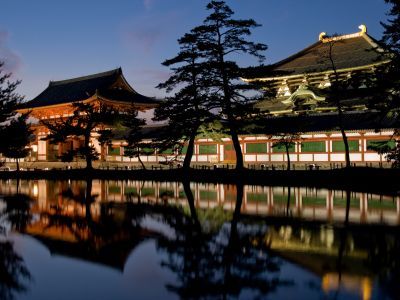Nara marks anniversary of its capital years

The capital of feudal Japan for a mere 74 years from 710, Nara is nevertheless marking its short reign with a series of celebratory events.
Recognized as a UNESCO World Heritage Site, the city has been largely left in the shadow of nearby Kyoto, but is hoping to raise its profile by commemorating its rise to power 1,300 years ago.
Many of the city's major temples are staging special exhibitions and will be displaying statues and opening up buildings and cultural treasures that have been previously been closed to the public.
Celebrations get fully under way on April 24, with the opening of a new museum dedicated to the years when Heijokyo - as the capital was then known - was at its peak.
The museum is designed to explain the early stages of the building of the Japanese nation, as well as the life and cultures of ancient times. It will have a range of exhibition areas and two theaters to demonstrate the magnificence of the city. Visitors are also able to see the remains of some of the key buildings in the city, including the Heijo Palace and districts where ordinary people lived.
The palace will also be at the center of the Flower and Greenery Fair from late April until May 9.
Commemorative events throughout the city will also include parades and demonstrations of ancient performing arts, a light and candle fair as well as song and dance performances.
The main hall of the former Imperial Audience Hall, where state ceremonies were held in the presence of the emperor, has been reconstructed and will serve as the venue for celebrations with dignitaries from around the world.
One of the highlights of the year will be the display of a life-size replica of the Kentoshi-sen, a ship that took diplomatic missions to the leaders of the Tang Dynasty in China, near the Heijokyo site.
The seat of the Imperial Court was later transferred to Kyoto, which was known as Heian-kyo at the time, and Nara's importance began to wane. That has its benefits, however, as Nara has retained its small-town feel and does not suffer from hordes of tourists every year.
The top landmarks include Todai-ji temple - the largest wooden building in the world and home of the largest statue of the Buddha Vairocana - and the Kasuga Shinto shrine. Nara is also known for the deer that can be seen walking amongst the visitors.
Getting there: Nara is a 40-minute train journey from Osaka.
Further information: The Nara Tourism Office: +81 742 232 010 http://www.1300.jp/foreign/english/index.html
JR
Subscribe to Independent Premium to bookmark this article
Want to bookmark your favourite articles and stories to read or reference later? Start your Independent Premium subscription today.

Join our commenting forum
Join thought-provoking conversations, follow other Independent readers and see their replies